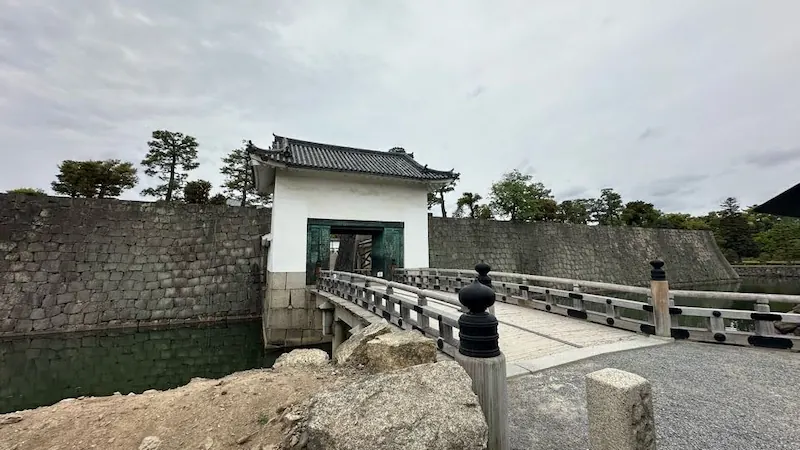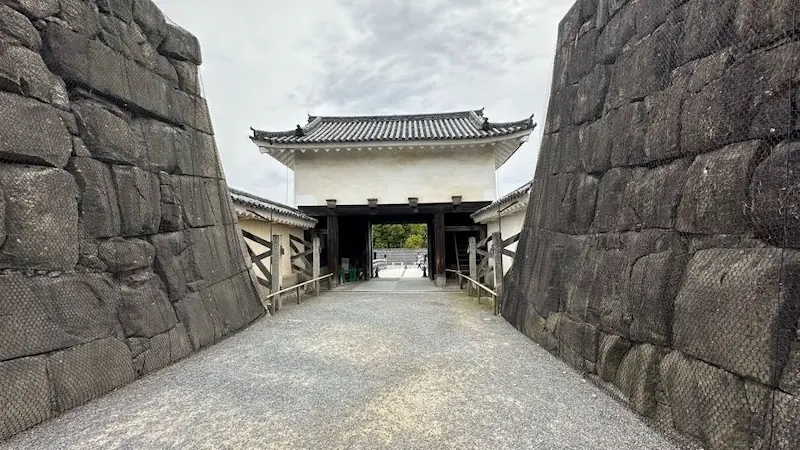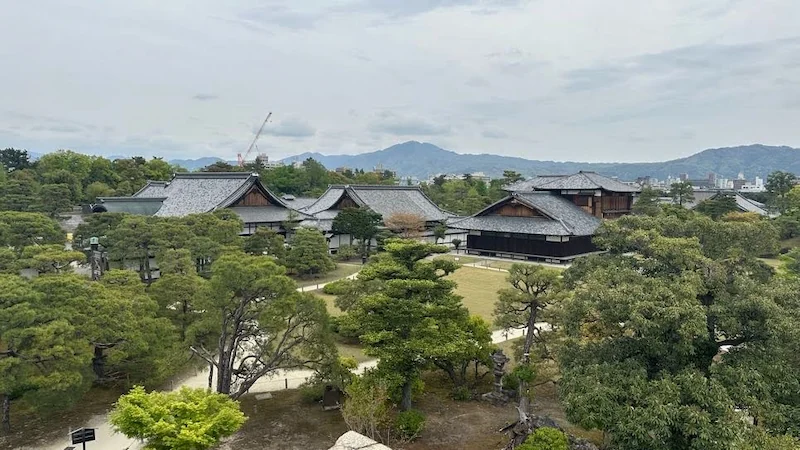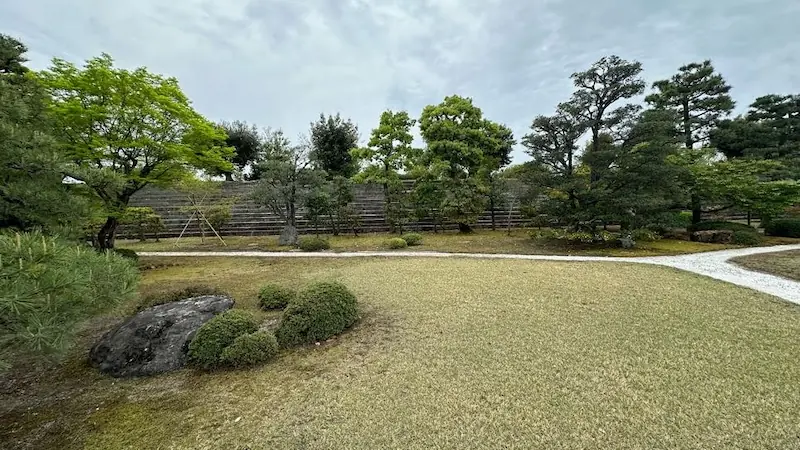The “Sky Corridor” the Emperor Once Walked: Higashi-bashi
If you want to feel the deeper layers of Nijo Castle’s history, don’t miss “Higashi-bashi” and the “Honmaru Yaguramon.”
These two structures—iconic of early Edo-period fortification theory and ceremonial space—are masterpieces of functional beauty, balancing defense and prestige. From the elevated “sky corridor” once used by the Emperor to the surviving gatehouse architecture, the design reveals the behind-the-scenes stagecraft that helped shape Japan’s history.
Higashi-bashi

🏛 Overview
Higashi-bashi is the sole route connecting the Ninomaru Garden across the inner moat to the Honmaru. It embodies the early Edo-period concept of prioritizing “Honmaru defense.” Together with the Honmaru Yaguramon, the bridge was engineered to block enemy intrusion. Structurally, it is a timber girder bridge; robust hardwoods were used for the railing and deck, producing a restrained yet elegant design that unites beauty with battlefield-ready function.
Historically, a roofed two-story corridor called the “Nikai-bashi” stood on this bridge. During the imperial visit of Emperor Go-Mizunoo in 1626 (Kanei 3), it served as an elevated “sky corridor,” allowing the Emperor to proceed to the Honmaru tenshu (main keep) without setting foot on the ground. In other words, the bridge held political and ceremonial importance far beyond that of a mere crossing—underscoring Nijo Castle’s stature and the complexity of its spatial planning.
| Item | Details |
|---|---|
| Year Built | Estimated 1626 (Kanei 3), erected during improvements to the Honmaru for Emperor Go-Mizunoo’s visit |
| Builder | Tokugawa Shogunate (likely constructed under the supervision of the Kyoto Shoshidai) |
| Structure & Features | Timber girder bridge. Spans the inner moat on the east side of the Honmaru; served as an ordinary passage in peacetime, and is said to have had a drop mechanism (a movable bridge) for defense in wartime. |
| Repairs & Restoration | Documented repairs in the Meiji and Showa eras. Maintained in recent years as a wooden bridge. |
| Current Status | Extant. Usually part of the visitor route, though access may be restricted during maintenance or construction. |
| Loss/Damage | No records of total destruction or loss by fire. |
| Cultural Property Status | Regarded as part of the castle’s structural ensemble; not designated as a standalone cultural property. |
| Notes | The Honmaru East Bridge is a key remnant illustrating Nijo Castle’s defensive design. A counterpart West Bridge also existed; together they formed the critical in-and-out routes for the Honmaru. |
🗺 Address:
541 Nijojo-cho, Horikawa-nishiiru, Nijo-dori, Nakagyo-ku, Kyoto-shi, Kyoto 604-8301, Japan
🚶 Access
About 2 minutes on foot (approx. 150 m) from the Ninomaru Garden
⏳ Suggested Time
Quick highlights: about 5 minutes
Leisurely visit: about 10–15 minutes (including the moat and Honmaru Yaguramon)
📍 Highlights
🔹 Harmony of moat and bridge: The mirror-like inner moat set against the straight lines of Higashi-bashi makes this a popular photo spot.
🔹 The vanished “Nikai-bashi”: A roofed tatami-lined corridor once stood atop this bridge as an exclusive imperial passage. While it no longer survives, traces and some elements are preserved in a storehouse.
🔹 Strategic placement: Higashi-bashi deliberately funnels any attacker into a single approach, making it a crucial defensive chokepoint.
📌 Trivia
💡 A surprising historical thread: Even after the Meiji era, this remained the only route linking the Honmaru and Ninomaru. Records show it was used to guide members of the imperial family and foreign dignitaries on inspections.
💡 Insider note: Although the current bridge has undergone repairs, its basic structure and position faithfully follow the Edo-period original.
💡 Famous connections: During the Taisho enthronement ceremonies, the route to the Honmaru included this bridge, which also appears in security logs from the time.
Honmaru Yaguramon

🏛 Overview
The Honmaru Yaguramon is the symbolic gateway of the Honmaru, forming a critical segment of the inner moat’s defensive line. Built during the grand renovation directed by Tokugawa Iemitsu in 1626 (Kanei 3), it stands alongside the tenshu and Honmaru palace as a centerpiece of early Edo political-ritual space.
This two-story gatehouse features a hip-and-gable roof tiled in heavy hon-kawara. The lower level serves as the passageway; the upper level functioned as a defensible lookout armed with bows and matchlocks. Among the Honmaru buildings, this gate alone survived the Great Fire of 1788 (Tenmei 8), making it an exceptionally rare remnant.
Inside, the gate once had loopholes for firearms and “ishi-otoshi” (openings for dropping stones or projectiles), allowing defenders to strike attackers advancing across the bridge. These features speak to the stringent security enforced whenever the shogun or the Emperor was in residence.
| Item | Details |
|---|---|
| Year Built | Circa 1625–1626 (Kanei 2–3) |
| Builder | Tokugawa Shogunate (part of Iemitsu’s Honmaru development) |
| Structure & Features | Yaguramon (gatehouse) style with hip-and-gable roof, tiled with hon-kawara. Doors clad in copper plates to improve fire resistance. Equipped with a mechanism to drop the wooden bridge in wartime. Gun ports (loopholes) incorporated into the inner earthen walls to strengthen defense. While the exterior appears restrained, defensive mechanisms are integrated throughout. |
| Repairs & Restoration | Has undergone damage and repairs since construction; detailed restoration records are limited. Structural and decorative repairs and reinforcements have been carried out. Gate doors and bridge components may have been repaired or replaced in later periods. |
| Current Status | Extant. Designated an Important Cultural Property of Japan. Retains doors and defensive fittings that once served as the main fortified entrance to the Honmaru. |
| Loss/Damage | The West Honmaru Yaguramon was lost to fire; both once formed a paired defensive system for the Honmaru. Some components and bridge materials were dismantled and preserved, reportedly in a state allowing potential reassembly. |
| Cultural Property Designation | Important Cultural Property of Japan (designated October 28, 1939) |
| Notes | Located immediately beyond Higashi-bashi, serving as the entrance from the Ninomaru to the Honmaru. Equipped for siege defense: drop-bridge mechanism, copper-clad doors, and gun ports. Outwardly solid yet modestly adorned—prioritizing function as a military gate. Built alongside the Honmaru palace, forming the castle’s core defensive line. |
🗺 Address:
541 Nijojo-cho, Horikawa-nishiiru, Nijo-dori, Nakagyo-ku, Kyoto-shi, Kyoto 604-8301, Japan
🚶 Access
Right across Higashi-bashi; about 1 minute on foot (14 m)
⏳ Suggested Time
Quick highlights: about 10 minutes
Leisurely visit: about 20–30 minutes (to appreciate structure and historical context)
📍 Highlights
🔹 Defensive ingenuity: Copper-clad, fire-resistant doors; upper-level loopholes; and “stone-drop” features—numerous elements designed for real combat scenarios.
🔹 The only Edo-period building remaining in the Honmaru: While the Honmaru Palace and tenshu were lost to fire, this gate survives to convey the architecture of the time.
🔹 Linked to the Emperor’s private corridor: During the Kanei imperial visit, the second-story corridor of the “Nikai-bashi” connected to this gate, forming part of a route that allowed the Emperor to reach the tenshu without touching the ground.
📌 Trivia
💡 A surprising background: The copper plates were a fire-preventive measure against early firearms like matchlocks—reflecting a warlike tension distinct from the Kyoto Imperial Palace.
💡 Insider note: The second story is usually closed to the public, but surveys during cultural property conservation revealed interior layouts and materials—valuable data for early Edo architecture.
💡 Famous connections: During the 1867 Restoration, aides to Tokugawa Yoshinobu reportedly tightened security at this gate to keep confidential councils within the Honmaru from leaking.
Former Imperial Villa Nijo Castle

🏛 Overview
Former Imperial Villa Nijo Castle was built in 1603 (Keicho 8) by Tokugawa Ieyasu to assert the political legitimacy of the Edo Shogunate and to protect the western approaches to the Kyoto Imperial Palace. The “Former Imperial Villa” title reflects its transfer to the Imperial Household Ministry in 1884 (Meiji 17) and subsequent use as an imperial villa; today, it is owned and managed by the City of Kyoto.
The castle functioned as the shogun’s Kyoto residence, a stage for ceremonies and governance. In 1626, the third shogun Tokugawa Iemitsu carried out a major renovation to welcome Emperor Go-Mizunoo’s visit, turning the castle into a national ceremonial venue. With architecture steeped in Momoyama aesthetics, magnificent Kano-school murals, and stately shoin-style halls, Nijo Castle embodies the pinnacle of architecture, fine arts, and landscape design while projecting shogunal authority at home and abroad.
In 1867, the 15th shogun Tokugawa Yoshinobu announced the “Taisei Hokan” (the return of political power to the Emperor) here—making Nijo Castle a symbolic stage for a pivotal shift in Japan’s history. Bearing witness to both the “beginning and end” of shogunal rule, Nijo Castle was inscribed in 1994 as part of the UNESCO World Heritage Site “Historic Monuments of Ancient Kyoto.”
| Item | Details |
|---|---|
| Year Built | Completed in 1603 (Keicho 8); construction began in 1601 |
| Builder | Tokugawa Ieyasu (Edo Shogunate) |
| Structure & Features | Flatland castle. Double moats and double baileys (inner and outer compounds). Key buildings include the six-part Ninomaru Palace, Karamon gate, gatehouses, gardens, and corner turrets. Decorative features include Kano-school murals and gilded metalwork, projecting august authority. |
| Repairs & Restoration | Major expansion and renovation under Tokugawa Iemitsu from 1624 onward. Repeated repairs following fires and lightning strikes. Converted to an imperial villa after the Meiji era; transferred to Kyoto City in 1939. |
| Current Status | Ninomaru Palace, Karamon, corner turrets, and gardens survive. Ninomaru Palace is a National Treasure; the garden is a Special Place of Scenic Beauty. Part of the UNESCO World Heritage Site “Historic Monuments of Ancient Kyoto.” |
| Loss/Damage | The tenshu was destroyed by lightning in 1750 (Kan’en 3). The Great Fire of 1788 (Tenmei 8) consumed the Honmaru Palace and other structures, which were not rebuilt. |
| Cultural Property Designations | Ninomaru Palace: National Treasure (1952) Ninomaru Garden: Special Place of Scenic Beauty (1953) Many gatehouses and turrets are Important Cultural Properties. Inscribed in 1994 on the UNESCO World Heritage List as part of “Historic Monuments of Ancient Kyoto.” |
| Notes | In 1867 (Keio 3), Tokugawa Yoshinobu proclaimed the Taisei Hokan in the Ninomaru Palace. The name “Former Imperial Villa” reflects its Meiji-era use as an imperial retreat. In 2024, the Honmaru Palace opened to the public for the first time in about 18 years. |
🗺 Address:
541 Nijojo-cho, Horikawa-nishiiru, Nijo-dori, Nakagyo-ku, Kyoto-shi, Kyoto 604-8301, Japan
🚶 Access
Nearest station: About 2 minutes on foot (approx. 0.2 km) from “Nijojo-mae” Station on the Tozai Subway Line
⏳ Suggested Time
Quick highlights: about 60 minutes
Leisurely visit: about 2–3 hours (to take time with each building, garden, and exhibition)
📍 Highlights
🔹 Ninomaru Palace (National Treasure): The only surviving castle palace where Tokugawa shoguns conducted state affairs. Notable for exquisite Kano-school murals and “nightingale floors.”
🔹 Ninomaru Garden (Special Place of Scenic Beauty): A strolling pond garden by Kobori Enshu, featuring stone groupings and a layout reflecting the Isle of the Blessed (Horai) ideal.
🔹 Honmaru Yaguramon & Honmaru Garden: The defensive gate symbolizing the Honmaru and the garden arranged in the Meiji era for the imperial household.
🔹 Seasonal pleasures: In spring, around 300 cherry trees bloom; in autumn, fall foliage colors the entire site. Evening illumination events are held regularly.
📌 Trivia
💡 A surprising historical thread: Nijo Castle spent long periods without a tenshu after it burned in 1750; it was never rebuilt—suggesting the shogunate prioritized prestige over pure military defense in Kyoto.
💡 Insider note: Guard posts for the “Nijo Zaiban” (resident samurai detail) once dotted the grounds; today, only one post survives beside the East Otemon Gate.
💡 Famous connections: Grand celebrations were held here for the enthronements of the Meiji and Taisho Emperors, and buildings across the site still preserve traces of that pageantry.
Honmaru Garden

🏛 Overview
The Honmaru Garden spreads south of where the Honmaru Palace once stood—the core venue for shogunal governance and ceremony—and today it presents a modern lawn-garden style crafted in the Meiji era.
Although the Honmaru Palace was lost in the Great Tenmei Fire of 1788, the garden that encircles the site was redesigned in 1896 (Meiji 29) to prepare for Emperor Meiji’s visit. Unlike the severe, solemn gardens of the Edo period, this one pairs broad lawns with curving paths and an artificial hill (the “Moon-Viewing Platform”), blending an approachable atmosphere with imperial refinement.
This space is both the “final stage” of the Tokugawa shoguns and, after 1868, a “garden of welcome” for a new era—letting visitors feel the intersection of ages. At dusk, shadows stretching across the lawn and the view from the hill evoke a quiet vigil over past and future alike.
| Item | Details |
|---|---|
| Year Built | Meiji era (newly created after the Honmaru palace relocation) |
| Builder | Unknown (includes relocation/modification of the Katsura-no-miya Palace) |
| Structure & Features | A lawn encircled by curvilinear paths, with ornamental stones and an artificial hill (Moon-Viewing Platform). Integrated with the Gojou-no-Goten; distant views to Mount Hiei to the left rear. The original concept referenced late Heian styles but was later reworked into a modern composition. |
| Repairs & Restoration | Redesigned in 1895 (Meiji 28) ahead of Emperor Meiji’s visit. Stones and trees were reused; the overall plan was reset and re-drawn from scratch. |
| Current Status | Extant. Open to the public and viewable when the Honmaru Palace area is open. |
| Loss/Damage | No record of large-scale destruction. |
| Cultural Property Status | No standalone designation confirmed for the garden itself. |
| Notes | The garden was created when the Katsura-no-miya Palace was moved into the Honmaru. Initially conceived with late-Heian motifs, it was dramatically altered by order for the 1895 visit, yielding today’s appearance. Incorporates modern elements such as lawn, the Moon-Viewing Platform, and ornamental stonework. |
🗺 Address:
541 Nijojo-cho, Horikawa-nishiiru, Nijo-dori, Nakagyo-ku, Kyoto-shi, Kyoto 604-8301, Japan
🚶 Access
About 1 minute on foot (approx. 50 m) from the Honmaru Yaguramon
⏳ Suggested Time
Quick highlights: about 10 minutes
Leisurely visit: about 30 minutes (climb the hill and take in the full panorama)
📍 Highlights
🔹 Lawn and Moon-Viewing Platform:
A small hill on the southeast served as a “moon-viewing” spot. From the top, you can overlook the former Honmaru Palace site and parts of the Ninomaru Palace—beautiful in every season.
🔹 A touch of Western taste:
Characteristic of the Meiji era, the garden features curving paths, expansive lawns, and open sightlines—an elegant fusion of Emperor Meiji’s sensibilities and imperial garden formality.
🔹 Dialogue with the Honmaru Palace ruins:
The contrast between the surviving foundation stones and the vibrant garden foregrounds the passage of time and the transformation of space.
🔹 Seasonal pleasures:
Shidare-zakura (weeping cherry) bloom around the hill in spring; in autumn, fallen leaves color the lawn. On frosty winter mornings, the white turf creates a serene tableau.
📌 Trivia
💡 A surprising historical thread:
The site once held a dry landscape garden in the Edo period, but it was transformed under Emperor Meiji’s direction—marking a symbolic turning point of “rupture and rebirth” in Japanese garden history.
💡 Insider note:
Though not open to the public, a modest structure known as the “Goyusho” (Rest Pavilion) is thought to have stood on the hill, possibly used as a temporary waiting area during imperial visits in the Meiji era.
💡 Famous connections:
Historical records state that both Emperor Meiji and Emperor Taisho passed through this garden en route to the Honmaru, with imperial pageantry such as honor guards and enhanced landscaping marking their processions.



comment